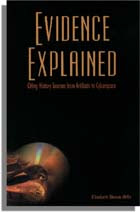I was very excited to recently receive a copy of Evidence Explained: Citing History Sources from Artifacts to Cyberspace by Elizabeth Shown Mills (Genealogical Publishing Company, Baltimore, Maryland, 2007). As most of you are aware, this is the hot new book in the genealogical world. If you've been researching your family tree for any length of time, you probably recognize that the author is considered the leading authority in properly citing one's sources in genealogical research. Her last book on the subject, Evidence! Citation and Analysis for the Family Historian (also from GPC, 1997) and her publication, QuickSheet: Citing Online Historical Resources Evidence! Style (First Revised Edition, GPC, 2007), are integral to personal and public genealogical libraries around the country, if not the world.
The first thing I noticed about Evidence Explained was the thickness and weight of the tome. While Evidence! is a paperback of 124 pages, and QuickSheet is a reference sheet published as a laminated folder for quick reference while working online, Evidence Explained is an 885-page hardback, weighing approximately 3 pounds! There's good reason for the size of the book. Ms. Mills has packed it full of lessons on analysis and citation as well as explanations and examples of sources and their corresponding citations.
In the first chapter, "Fundamentals of Evidence Analysis," the author sets forth to instruct her readers on the necessity of analyzing the sources that genealogists and family historians come across while doing their research. It is not enough to have sources, she says; it is imperative that we learn to evaluate the quality of the source and step back to critique the circumstances under which the source was created, copied, archived, and presented to the public. This chapter is subdivided into the following topics: Basic Issues, Classes of Evidence, Problematic Concepts, Processed Records (Formats), and Textual Criticism.
The second chapter is "Fundamentals of Citation," and its lessons are partitioned so: Basic Issues, Common Practices for Citing, Family History Library, Online Materials, Organization, and Stylistic Matters. A quote near the beginning of the chapter sets the stage for its purpose: "...once we have learned the principles of citation, we have both an artistic license and a researcher's responsibility to adapt those principles to fit materials that do not match any standard model" [pg. 41]. Since genealogists make discoveries in the most unusual sources (jewelry, family needlework and portraits, or personal mementos, for instance), "Fundamentals of Citation" gives both the structure and the liberty that each family historian needs to cite the facts unique to his or her own circumstances. These first two chapters ought to be required reading for anyone who is serious--or merely curious--about learning and recording the history of their family. They will answer questions and provide solutions to problems the reader may not have even previously considered.
The next twelve chapters present the examples and explanations of various types of sources, and are accordingly titled:
- * "Archives & Artifacts"
- * "Business & Institutional Records
- * "Cemetery Records"
- * "Census Records"
- * "Church Records"
- * "Local & State Records: Courts & Governance
- * "Local & State Records: Licenses, Registrations, Rolls & Vital Records"
- * "Local & State Records: Property & Probates"
- * "National Government Records"
- * "Publications: Books, CDs, Maps, Leaflets & Videos"
- * "Publications: Legal Works & Government Documentation"
- * "Publications: Periodicals, Broadcast & Web Miscellanea"
Although I've had this book for less than a month, I'm already finding that I'm using it on almost a daily basis, either for citing my sources in my family tree databases or here on my blog. It's everything I had hoped to find when I purchased the author's previous book on this topic. Evidence! left me a bit bewildered because I had so many source circumstances that didn't fit neatly into the models she gave. However, Evidence Explained not only gives me a wealth of examples that have, so far, covered every situation I've come across, but teaches me how to determine citations for examples she may not have given. As well, the lessons of the first two chapters were educational and enlightening for me, a genealogist by avocation.
To purchase your own copy of Evidence Explained, visit the website of the publisher, Genealogical Publishing Company.

4 comments:
Hi Miriam,
I hope that you had a nice Christmas.
What a comprenhensive book...It's going to take everyone back to the bases.
Where I'am coming from ( living in Europe with very little access to US sources), all of these sources might be sounding like a wiSh list!
If I don't get here before the new year, A Happy New Year to you and your family.
Thank you, Barbara! I always enjoy your visits and nice comments.
Evidence Explained is definitely a must-have for any genealogist's or family historian's personal library!
Thanks for the heads up Barbara. Now I think I'll use some of my birthday money to buy a copy.
Thomas, I hope you do get a copy of this book. It's a "must-have" for any genealogist's home library! I can't emphasize this enough!
Post a Comment